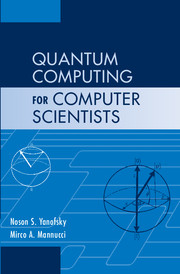Book contents
- Frontmatter
- Contents
- Preface
- Introduction
- 1 Complex Numbers
- 2 Complex Vector Spaces
- 3 The Leap from Classical to Quantum
- 4 Basic Quantum Theory
- 5 Architecture
- 6 Algorithms
- 7 Programming Languages
- 8 Theoretical Computer Science
- 9 Cryptography
- 10 Information Theory
- 11 Hardware
- Appendix A Historical Bibliography of Quantum Computing
- Appendix B Answers to Selected Exercises
- Appendix C Quantum Computing Experiments with MATLAB
- Appendix D Keeping Abreast of Quantum News: Quantum Computing on the Web and in the Literature
- Appendix E Selected Topics for Student Presentations
- Bibliography
- Index
4 - Basic Quantum Theory
Published online by Cambridge University Press: 05 June 2012
- Frontmatter
- Contents
- Preface
- Introduction
- 1 Complex Numbers
- 2 Complex Vector Spaces
- 3 The Leap from Classical to Quantum
- 4 Basic Quantum Theory
- 5 Architecture
- 6 Algorithms
- 7 Programming Languages
- 8 Theoretical Computer Science
- 9 Cryptography
- 10 Information Theory
- 11 Hardware
- Appendix A Historical Bibliography of Quantum Computing
- Appendix B Answers to Selected Exercises
- Appendix C Quantum Computing Experiments with MATLAB
- Appendix D Keeping Abreast of Quantum News: Quantum Computing on the Web and in the Literature
- Appendix E Selected Topics for Student Presentations
- Bibliography
- Index
Summary
Reality is that which, when you stop believing in it, does not go away.
Philip K. DickIn Chapters 1 and 2 we developed the necessary mathematical apparatus and terminology that will be used throughout this book. Chapter 3 has provided some heuristics and gently led us to the threshold of quantum mechanics. It is now time to open the door, introduce the basic concepts and tools of the trade, and continue our journey to quantum computing.
In Section 4.1 we spend a few words on the motivations behind quantum mechanics. We then introduce quantum states and how they are distinguishable from one another through observations. Section 4.2 describes observable physical quantities within the quantum framework. How observable quantities are measured is the topic of Section 4.3. The dynamics of quantum systems, i.e., their evolution in time, is the focus of Section 4.4. Finally, in Section 4.5, we revisit the tensor product and show how it describes the way in which larger quantum systems are assembled from smaller ones. In the process, we meet the crucial notion of entanglement, a feature of the quantum world that pops up again in the chapters ahead.
QUANTUM STATES
Why quantum mechanics? To answer this question, we have to hearken back in time to the dawn of the twentieth century. Classical mechanics still dominated the scene, with its double-pronged approach: particles and waves.
Information
- Type
- Chapter
- Information
- Quantum Computing for Computer Scientists , pp. 103 - 137Publisher: Cambridge University PressPrint publication year: 2008
